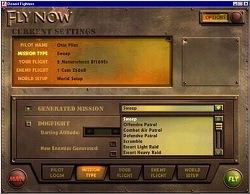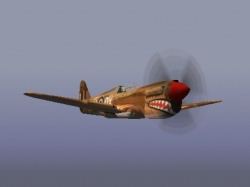|
Desert Fighters Interview
by Jim "Twitch" Tittle |
||||
|
Q: Tell us more about the campaign structure. How does it flow? You can choose to play for either one of the four "services": Royal Air Force, United States Army Air Force, Luftwaffe, or Regia Aeronautica. Additionally, you can choose to start the campaign on any one of four start dates: March 1941, January 1942, July 1942, and January 1943. As a pilot your job is, to put it simply, inflict damage to the enemy supply system while protecting your own side's supply assets. Generally speaking, the side which is able to maintain more of it's supplies will be the one that wins the war. Of course, transporting supplies over a considerable distance to the front results in attrition on the supplies, to the point where you would expend all of your supplies in simply transporting them to the front lines. At that point, your side would need to withdraw its forces to a more defensible line. As the ground forces advance and retreat, your unit will be moved forward or back as needed to maintain it within an effective operational distance from the front. In addition to incoming supplies, each service will receive replacement aircraft at various intervals. These replacements are distributed to squadrons to replace lost aircraft, with the remainder being placed into a reserve pool for future use. When new aircraft models are received, the most effective squadrons will get upgraded to the new models with the old models being relegated to the reserve pool. However, if a squadron incurs losses such that they cannot field a flight of aircraft and there are no more of that model available, the squadron can be reassigned to fly an older type, of which there is a sufficient quantity to equip the squadron. Each of the four campaign periods is divided into about 50 randomly generated missions. You may go several days without having a mission and, on days in which there is a ground battle taking place, you may be tasked with up to three missions per day. The battle ends and the game is over whenever one of the following conditions is met:
a. The campaign end date of December 31, 1943 is reached. Q: Let's talk about dynamics. Everyone has their own idea of what this means. What are the essentials of a dynamic campaign for Dynamix and how has the campaign engine changed and grown since Red Baron II? A: To my way of thinking, if a system is "dynamic" it is "reactive", i.e., it reacts to the user's input. Red Baron II/3D was dynamic in the sense that the real-world aces (Richthofen, Ball, etc.) were put into the world at their entrance date and could be then killed before their historical date of death or could be successful and live past their historical date of death. Likewise, other pilots in the world would have a life of their own once they entered the game, living or dying as their skill and fortune allowed. |
 However, other than the pilot's lives, there really wasn't any level of dynamism in the game. The front lines stayed at their historical locations, airfields were activated and deactivated according to an historical schedule, and even the missions, randomly generated though they were, were entirely static and non-reactive beyond the initial generation. Desert Fighters, on the other hand, is entirely reactive in almost every aspect of the game. All pilots in the world have names, abilities, and scoring records. Rather than giving the player an historical name, such as Marseilles, which they can expect would perform at a certain level, all the pilots are fictionally generated. Part of the fun in the campaign game will be identifying which pilots and units are the elite ones. Because each of these pilots have abilities that are revealed as they become more experienced, it is in your best interest to keep pilots on your side alive. Maybe it is better to take a failure on a mission rather than risk losing the majority of your pilots.
 P40e Secondly, our campaign game is entirely reactive. The abilities of the pilots has a direct bearing on their success in the air, which has a direct bearing on the supply levels, which has a direct bearing on the decisions and results of the ground war. It is entirely possible for the Axis to capture Alexandria and it is entirely possible for the campaign to result in a stalemate, with the front lines stabilizing somewhere near Tripoli. Finally, our mission generation system is entirely reactive. One of the things I wanted to avoid was the empty world syndrome that was prevalent whenever the player strayed from the assigned mission path or plan in a game like AOTP or AOE. I don't think it is possible for a lone fighter to go tooling around Northern France in 1944, beating up every airfield in sight, only to see nothing but small arms fire in return. In Desert Fighters, no matter where you go, you will have the chance of running into something: a supply column, a flight of enemy transport planes, a wandering patrol of Messerschmitts, or a flight of Stukas working over a friendly tank column. Or you may run into an outbound formation of enemy bombers and escorts on their way to your side to wreak havoc on some unknown location, which may be your own home airfield! These are but a few of the situations you will encounter as you fly around the North African skies. Go to Part III
|
|||
|
Copyright © 1997 - 2000 COMBATSIM.COM, INC. All Rights Reserved. Last Updated August 18th, 1999 |
||||
